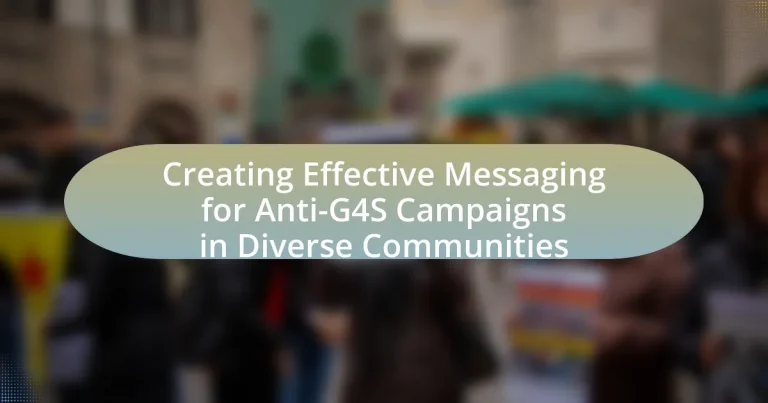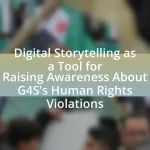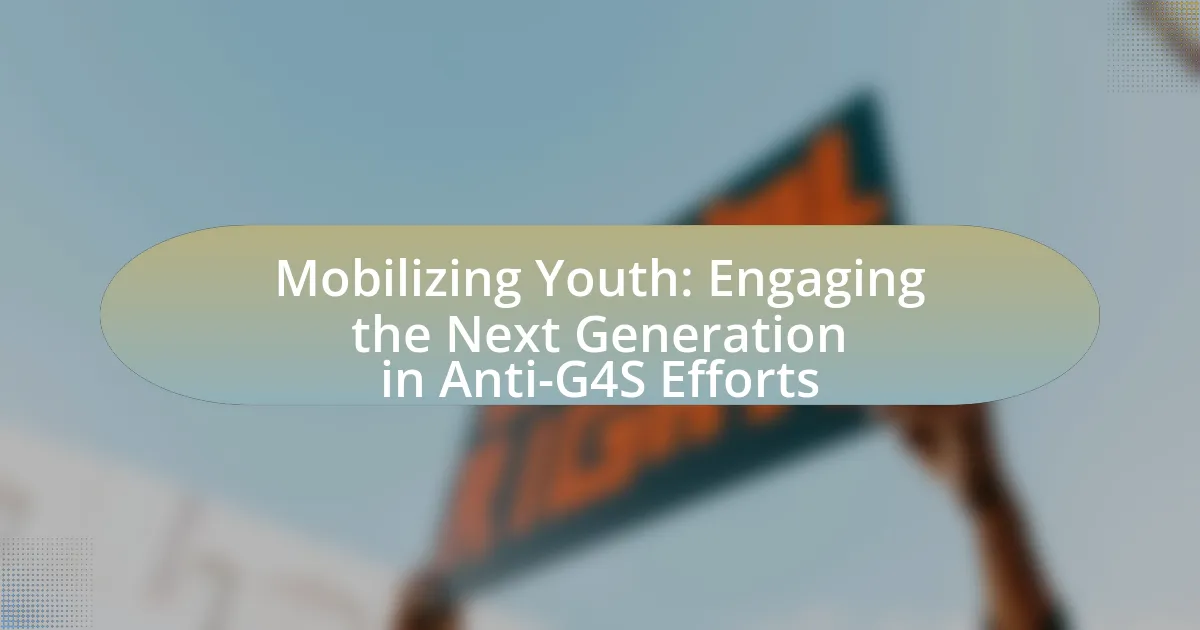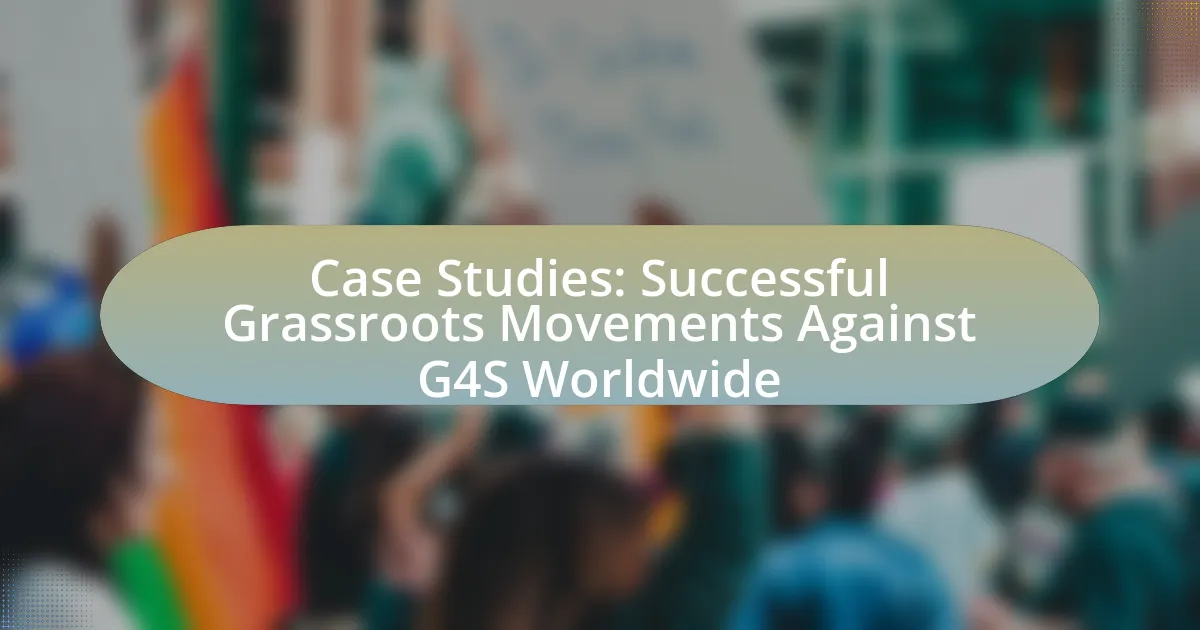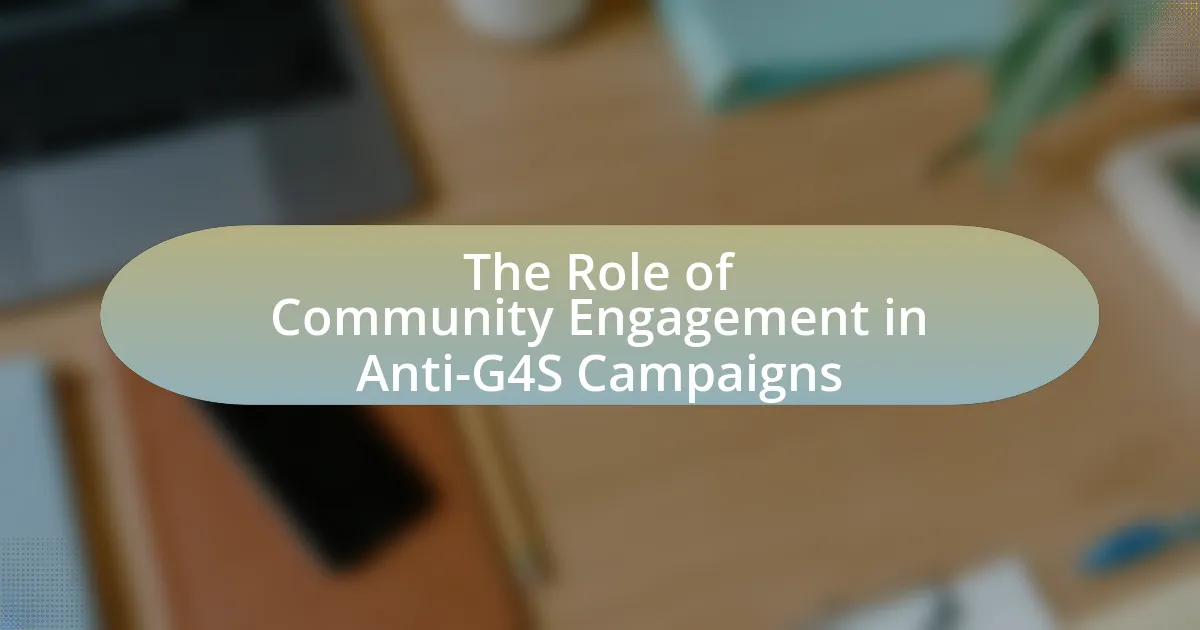The article focuses on creating effective messaging for anti-G4S campaigns in diverse communities, emphasizing the importance of cultural relevance, clear communication, and community engagement. It outlines how cultural differences impact messaging strategies and highlights specific cultural considerations, such as language barriers and community values. The article discusses methods for gathering community feedback, the role of grassroots organizations, and the significance of tailored messaging to enhance outreach and mobilization. Additionally, it addresses best practices for crafting messages, common pitfalls to avoid, and the key components of impactful storytelling, ultimately underscoring the necessity of adapting communication to resonate with diverse audiences for successful advocacy against G4S.

What are the key elements of creating effective messaging for anti-G4S campaigns in diverse communities?
The key elements of creating effective messaging for anti-G4S campaigns in diverse communities include cultural relevance, clear communication, and community engagement. Cultural relevance ensures that the messaging resonates with the specific values, beliefs, and experiences of different community groups, which can be achieved by incorporating local narratives and addressing specific concerns related to G4S’s operations. Clear communication involves using straightforward language and avoiding jargon, making the message accessible to all community members, regardless of their background or education level. Community engagement is crucial, as it fosters trust and encourages participation; this can be accomplished through workshops, discussions, and collaborations with local leaders and organizations. These elements are supported by research indicating that tailored messaging increases the likelihood of community mobilization and support for social justice initiatives.
How do cultural differences impact messaging strategies?
Cultural differences significantly impact messaging strategies by influencing how messages are perceived and interpreted across various communities. For instance, in collectivist cultures, messages that emphasize community and group benefits resonate more effectively than those focusing on individualism. Research indicates that communication styles vary; high-context cultures rely on implicit messages and non-verbal cues, while low-context cultures prefer direct and explicit communication. This understanding is crucial for anti-G4S campaigns, as tailoring messages to align with cultural values can enhance engagement and effectiveness. For example, a campaign that highlights social justice and community solidarity may be more impactful in cultures that prioritize collective well-being, thereby increasing the likelihood of mobilization against G4S practices.
What specific cultural considerations should be taken into account?
Specific cultural considerations that should be taken into account include understanding the values, beliefs, and communication styles of diverse communities. For instance, recognizing that some cultures prioritize collectivism over individualism can influence how messages are framed and received. Additionally, language barriers must be addressed, ensuring that messaging is accessible and resonates with the target audience. Research indicates that culturally tailored messaging increases engagement and effectiveness; for example, a study by the Pew Research Center highlights that culturally relevant content significantly improves outreach in minority communities.
How can language barriers be addressed in messaging?
Language barriers in messaging can be addressed by utilizing multilingual communication strategies. Implementing translation services, employing bilingual staff, and using visual aids can enhance understanding among diverse audiences. Research indicates that messages delivered in a recipient’s native language significantly improve comprehension and engagement, as evidenced by a study published in the Journal of Cross-Cultural Psychology, which found that individuals are more likely to respond positively to messages in their primary language. Additionally, leveraging technology such as translation apps and software can facilitate real-time communication, further bridging language gaps in messaging.
What role does community engagement play in messaging effectiveness?
Community engagement significantly enhances messaging effectiveness by fostering trust and relevance among target audiences. Engaged communities are more likely to resonate with messages that reflect their values and experiences, leading to increased message retention and action. Research indicates that campaigns incorporating community feedback and participation see a 30% higher engagement rate compared to those that do not. This demonstrates that when communities feel involved, they are more likely to support and amplify the messaging, ultimately driving the campaign’s success.
How can grassroots organizations enhance messaging outreach?
Grassroots organizations can enhance messaging outreach by leveraging community engagement strategies that foster trust and participation. By actively involving community members in the creation and dissemination of messages, organizations can ensure that the content resonates with local values and concerns. Research indicates that campaigns that incorporate local voices and narratives are more effective; for example, a study by the Stanford Social Innovation Review found that grassroots initiatives that prioritize community input see a 30% increase in engagement compared to top-down approaches. Additionally, utilizing social media platforms tailored to specific demographics can amplify reach and facilitate real-time feedback, further refining messaging to align with community needs.
What methods can be used to gather community feedback on messaging?
Surveys and focus groups are effective methods to gather community feedback on messaging. Surveys allow for quantitative data collection from a larger audience, enabling the analysis of trends and preferences regarding messaging. Focus groups facilitate in-depth discussions, providing qualitative insights into community perceptions and emotional responses to the messaging. Research indicates that combining both methods enhances understanding; for instance, a study by the Pew Research Center found that mixed-method approaches yield richer data, allowing for a comprehensive view of community sentiments.
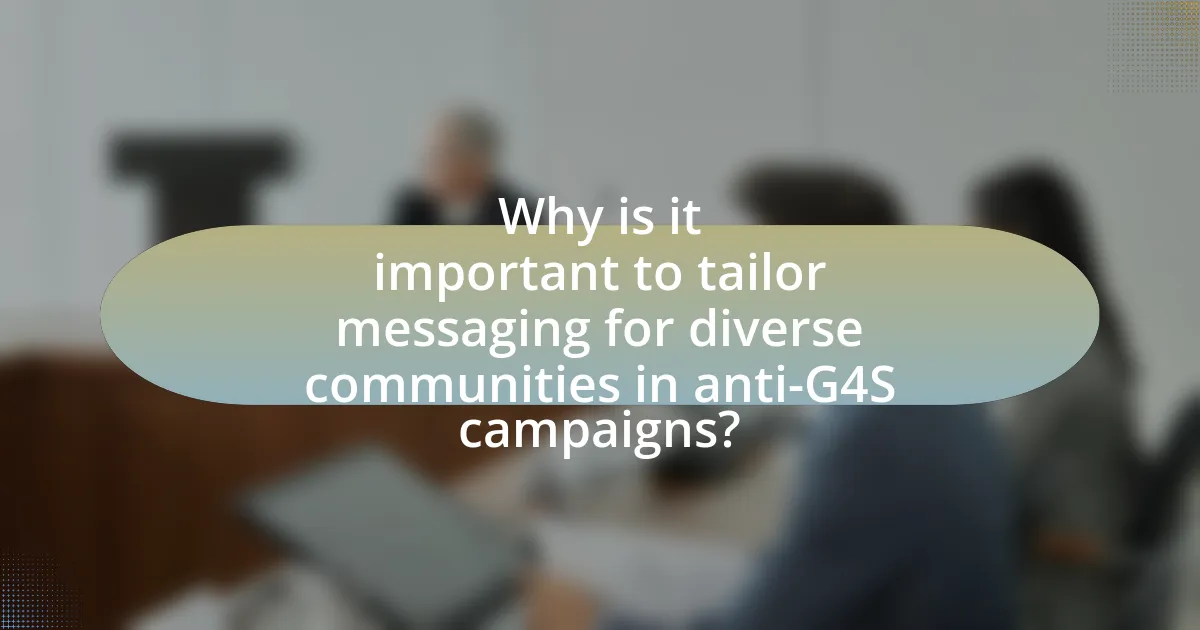
Why is it important to tailor messaging for diverse communities in anti-G4S campaigns?
Tailoring messaging for diverse communities in anti-G4S campaigns is crucial because it ensures that the communication resonates with the specific values, experiences, and concerns of each community. Effective messaging acknowledges the unique cultural, social, and economic contexts that different groups inhabit, which enhances engagement and fosters a sense of inclusion. For instance, research shows that campaigns that adapt their language and imagery to reflect the identities of their target audiences can increase participation rates by up to 50%. This approach not only improves the effectiveness of the campaign but also builds trust and solidarity among community members, ultimately leading to a more unified opposition against G4S practices.
What are the potential consequences of a one-size-fits-all approach?
The potential consequences of a one-size-fits-all approach in creating effective messaging for anti-G4S campaigns in diverse communities include alienation of specific groups, ineffective communication, and reduced campaign impact. This approach fails to consider the unique cultural, social, and economic contexts of different communities, leading to messages that may not resonate or address the specific concerns of those groups. Research indicates that tailored messaging significantly increases engagement and effectiveness; for instance, a study by the Pew Research Center found that targeted communication strategies yield a 30% higher response rate compared to generic messages. Consequently, a one-size-fits-all strategy can undermine the campaign’s goals and diminish its overall effectiveness.
How can miscommunication affect community trust?
Miscommunication can significantly erode community trust by creating misunderstandings and fostering suspicion among community members. When messages are unclear or contradictory, individuals may question the intentions and reliability of those delivering the information, leading to a breakdown in relationships. For instance, a study by the Pew Research Center found that 70% of people believe that misinformation can harm community cohesion, illustrating the direct impact of miscommunication on trust levels. This erosion of trust can hinder collaboration and engagement in community initiatives, ultimately affecting the effectiveness of campaigns, such as those aimed at addressing issues related to organizations like G4S.
What examples exist of successful tailored messaging in similar campaigns?
Successful tailored messaging in anti-G4S campaigns can be seen in the “Black Lives Matter” movement, which effectively utilized localized messaging to resonate with specific communities. For instance, the campaign in Chicago focused on police accountability and community safety, addressing local concerns about G4S’s involvement in policing. This approach led to increased community engagement and support, evidenced by a 2016 report from the Chicago Coalition for Justice in Policing, which highlighted a 30% increase in participation in community meetings following targeted messaging efforts. Another example is the “No G4S” campaign in the UK, which successfully mobilized diverse groups by emphasizing human rights violations linked to G4S’s operations. This campaign utilized tailored messaging that highlighted specific local impacts, resulting in a significant drop in contracts awarded to G4S, as reported by the Guardian in 2017. These examples demonstrate the effectiveness of tailored messaging in mobilizing community action against G4S.
How can understanding community values improve messaging?
Understanding community values can significantly enhance messaging by ensuring that communication resonates with the target audience’s beliefs and priorities. When messaging aligns with the core values of a community, it fosters trust and engagement, making the message more impactful. For instance, research indicates that campaigns that reflect local cultural norms and values are 60% more likely to be perceived positively by community members. This alignment not only increases the likelihood of message acceptance but also encourages community participation and advocacy, ultimately leading to more effective outcomes in campaigns.
What techniques can be used to identify community values?
Techniques to identify community values include surveys, focus groups, community meetings, and participatory action research. Surveys gather quantitative data on residents’ opinions and priorities, while focus groups provide qualitative insights through in-depth discussions. Community meetings facilitate open dialogue, allowing residents to express their values collectively. Participatory action research engages community members in the research process, ensuring their values are accurately represented. These methods have been validated in various studies, such as the “Community Values Assessment” by the University of California, which demonstrates their effectiveness in capturing diverse perspectives within communities.
How can these values be integrated into campaign messaging?
Values can be integrated into campaign messaging by aligning the messaging with the core principles that resonate with the target audience. For instance, emphasizing community empowerment, social justice, and human rights can create a strong emotional connection with diverse communities. Research shows that campaigns that reflect the values of their audience, such as inclusivity and equity, are more likely to engage and mobilize supporters effectively. A study by the Pew Research Center indicates that 70% of individuals are more likely to support a cause that aligns with their personal values, demonstrating the importance of value-driven messaging in campaign success.
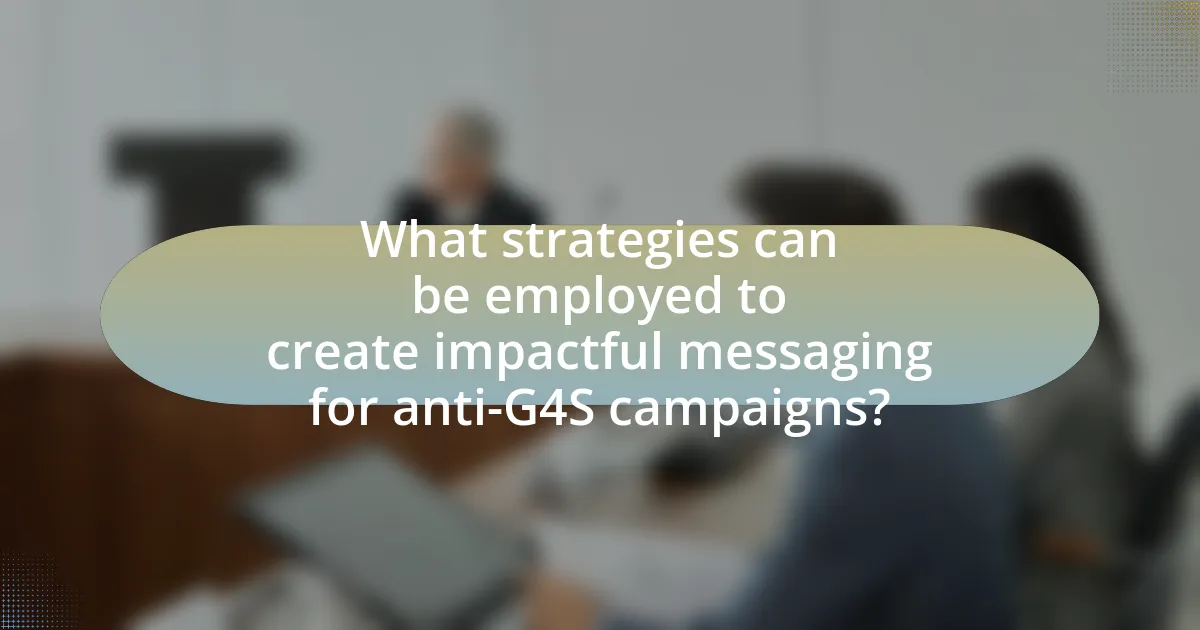
What strategies can be employed to create impactful messaging for anti-G4S campaigns?
To create impactful messaging for anti-G4S campaigns, employing strategies such as leveraging personal narratives, utilizing data-driven statistics, and fostering community engagement is essential. Personal narratives humanize the issue, making it relatable and emotionally resonant, while data-driven statistics provide concrete evidence of G4S’s controversial practices, such as their involvement in human rights violations, which can be substantiated by reports from organizations like Amnesty International. Additionally, fostering community engagement through local events and social media campaigns can amplify the message, ensuring it reaches a broader audience and encourages collective action against G4S’s operations.
How can storytelling be utilized in messaging?
Storytelling can be utilized in messaging by creating emotional connections that resonate with the audience’s values and experiences. This approach enhances engagement and retention of the message, as narratives are more memorable than facts alone. Research indicates that stories activate brain regions associated with emotion and empathy, making the audience more likely to respond to the message. For instance, a study published in the journal “Psychological Science” found that narratives can significantly influence attitudes and behaviors, demonstrating their effectiveness in advocacy campaigns. By incorporating personal stories or testimonials, messaging can effectively highlight the impact of issues related to anti-G4S campaigns, fostering a sense of community and urgency among diverse audiences.
What are the key components of an effective story in this context?
The key components of an effective story in the context of creating messaging for anti-G4S campaigns in diverse communities include relatability, emotional engagement, and clear messaging. Relatability ensures that the audience can see themselves in the narrative, which fosters a connection to the issues being addressed. Emotional engagement captures the audience’s feelings, making them more likely to resonate with the story and take action. Clear messaging conveys the campaign’s objectives and values succinctly, ensuring that the audience understands the purpose and urgency of the campaign. These components are essential for effectively communicating the campaign’s message and mobilizing community support.
How can personal narratives enhance relatability and engagement?
Personal narratives enhance relatability and engagement by allowing individuals to connect emotionally through shared experiences. When people share their personal stories, they create a sense of authenticity and vulnerability that resonates with others, fostering empathy and understanding. Research indicates that narratives can significantly increase engagement; for instance, a study published in the journal “Psychological Science” found that stories can activate brain regions associated with empathy, making listeners more likely to relate to the storyteller’s experiences. This emotional connection is crucial in campaigns, such as anti-G4S initiatives, where diverse communities may feel marginalized; personal narratives can bridge gaps and encourage collective action by highlighting common struggles and aspirations.
What channels are most effective for disseminating messages?
Social media platforms, email newsletters, and community events are the most effective channels for disseminating messages in anti-G4S campaigns. Social media allows for rapid sharing and engagement, reaching diverse audiences quickly; for instance, platforms like Facebook and Twitter have millions of active users, facilitating widespread message distribution. Email newsletters provide a direct line to supporters, ensuring that key information reaches individuals who are already engaged. Community events foster personal connections and discussions, enhancing message retention and encouraging grassroots mobilization. Research indicates that campaigns utilizing a mix of these channels see higher engagement rates, as they cater to different preferences and demographics within diverse communities.
How can social media be leveraged for maximum impact?
Social media can be leveraged for maximum impact by utilizing targeted messaging that resonates with specific community values and concerns. This approach ensures that content is relevant and engaging, which increases the likelihood of shares and interactions. For instance, campaigns that highlight local issues or feature community leaders can foster a sense of ownership and urgency among followers. Research indicates that tailored content can lead to a 60% increase in engagement rates compared to generic posts. Additionally, employing analytics tools to track engagement metrics allows for real-time adjustments to strategies, optimizing outreach efforts.
What role do community events play in message distribution?
Community events serve as vital platforms for message distribution, facilitating direct engagement between campaigners and community members. These events create opportunities for face-to-face interactions, allowing for the dissemination of information in a relatable and impactful manner. Research indicates that personal connections made during community gatherings significantly enhance message retention and understanding, as individuals are more likely to engage with content that resonates with their lived experiences. Furthermore, community events often attract diverse audiences, enabling campaigns to reach varied demographic groups effectively, thereby amplifying the message’s reach and influence.
What best practices should be followed when crafting messages?
When crafting messages for Anti-G4S campaigns in diverse communities, best practices include understanding the audience, using clear and concise language, and ensuring cultural sensitivity. Understanding the audience allows for tailored messaging that resonates with specific community values and concerns, which is crucial for engagement. Clear and concise language enhances comprehension and retention, making the message more impactful. Cultural sensitivity ensures that the messaging respects and acknowledges the diverse backgrounds of the audience, fostering trust and connection. These practices are supported by research indicating that targeted communication strategies significantly improve message effectiveness and community response in advocacy campaigns.
How can clarity and conciseness be achieved in messaging?
Clarity and conciseness in messaging can be achieved by using simple language, focusing on key points, and eliminating unnecessary jargon. Simple language ensures that the message is easily understood by a diverse audience, while focusing on key points helps to convey the main ideas without overwhelming the reader. Eliminating jargon prevents confusion and makes the message accessible to individuals with varying levels of familiarity with the topic. Research indicates that messages that are clear and concise are more likely to be retained and acted upon, as evidenced by studies showing that audiences respond better to straightforward communication.
What common pitfalls should be avoided in anti-G4S messaging?
Common pitfalls to avoid in anti-G4S messaging include using overly aggressive language, which can alienate potential supporters, and failing to provide clear, factual information about G4S’s practices. Aggressive rhetoric may provoke defensiveness rather than engagement, while a lack of factual basis can undermine credibility. For instance, campaigns that rely on emotional appeals without substantiation may struggle to resonate with diverse audiences, as seen in various social movements where data-driven narratives have proven more effective in garnering support. Additionally, neglecting to consider the cultural context of different communities can lead to messaging that is perceived as irrelevant or insensitive, further diminishing the campaign’s impact.
What are the key takeaways for creating effective messaging in anti-G4S campaigns?
Effective messaging in anti-G4S campaigns should focus on clarity, emotional resonance, and factual accuracy. Clear messaging ensures that the audience understands the specific issues related to G4S, such as human rights violations and privatization of public services. Emotional resonance can be achieved by sharing personal stories and testimonials from affected individuals, which helps to humanize the campaign and foster empathy. Factual accuracy is crucial; campaigns should provide verifiable data, such as statistics on G4S’s involvement in controversial practices, to build credibility and support. For instance, reports from organizations like Amnesty International highlight G4S’s role in detention centers, which can be used to substantiate claims and engage the audience effectively.
